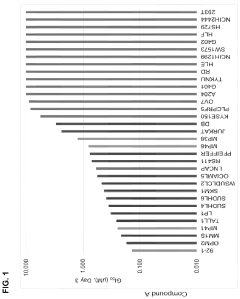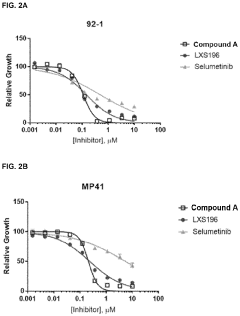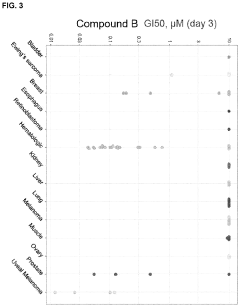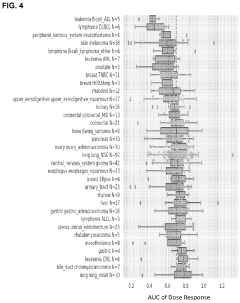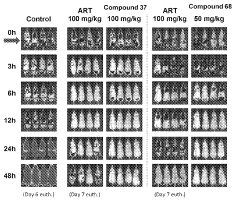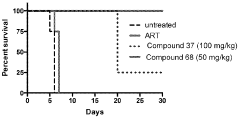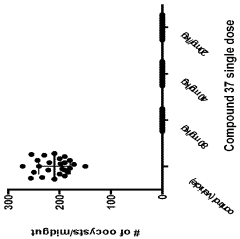Structural Dynamics of Geometric Isomers in Chiral Catalysis
AUG 1, 20259 MIN READ
Generate Your Research Report Instantly with AI Agent
Patsnap Eureka helps you evaluate technical feasibility & market potential.
Chiral Catalysis Background and Objectives
Chiral catalysis has emerged as a cornerstone in modern organic synthesis, playing a pivotal role in the production of pharmaceuticals, agrochemicals, and fine chemicals. The field has witnessed remarkable growth since the pioneering work of William S. Knowles, Ryoji Noyori, and K. Barry Sharpless, who were awarded the Nobel Prize in Chemistry in 2001 for their contributions to asymmetric catalysis.
The structural dynamics of geometric isomers in chiral catalysis represent a complex and fascinating area of study. This field explores how the three-dimensional arrangement of atoms in catalyst molecules influences their ability to selectively produce one enantiomer over another in chemical reactions. Understanding these dynamics is crucial for developing more efficient and selective catalytic processes.
The primary objective of research in this area is to elucidate the fundamental principles governing the relationship between catalyst structure and enantioselectivity. This involves investigating how subtle changes in the geometric configuration of chiral catalysts can dramatically affect their performance in asymmetric reactions. Researchers aim to develop predictive models that can guide the design of new, highly efficient chiral catalysts.
Another key goal is to unravel the mechanistic details of chiral catalytic processes at the molecular level. This includes studying the transition states of reactions, the nature of substrate-catalyst interactions, and the factors that determine the stereochemical outcome of reactions. Advanced spectroscopic techniques and computational methods are increasingly being employed to probe these aspects.
The field also seeks to expand the scope of chiral catalysis to new reaction types and challenging substrate classes. This involves developing catalysts capable of inducing asymmetry in previously inaccessible transformations, as well as improving the efficiency and selectivity of existing processes. There is a particular focus on creating catalysts that can operate under milder conditions, use less toxic reagents, and generate less waste, aligning with the principles of green chemistry.
Furthermore, researchers are exploring the potential of dynamic kinetic resolution and dynamic kinetic asymmetric transformations. These approaches leverage the interconversion of geometric isomers to achieve high yields of enantiopure products, even from racemic starting materials. Understanding and controlling the structural dynamics of catalysts and substrates is crucial for the success of these methodologies.
As the field advances, there is an increasing emphasis on developing sustainable and economically viable chiral catalytic processes for industrial applications. This involves addressing challenges such as catalyst recovery and recycling, as well as scaling up reactions while maintaining high levels of enantioselectivity. The ultimate aim is to establish chiral catalysis as a cornerstone technology for the efficient and environmentally friendly production of enantiomerically pure compounds on an industrial scale.
The structural dynamics of geometric isomers in chiral catalysis represent a complex and fascinating area of study. This field explores how the three-dimensional arrangement of atoms in catalyst molecules influences their ability to selectively produce one enantiomer over another in chemical reactions. Understanding these dynamics is crucial for developing more efficient and selective catalytic processes.
The primary objective of research in this area is to elucidate the fundamental principles governing the relationship between catalyst structure and enantioselectivity. This involves investigating how subtle changes in the geometric configuration of chiral catalysts can dramatically affect their performance in asymmetric reactions. Researchers aim to develop predictive models that can guide the design of new, highly efficient chiral catalysts.
Another key goal is to unravel the mechanistic details of chiral catalytic processes at the molecular level. This includes studying the transition states of reactions, the nature of substrate-catalyst interactions, and the factors that determine the stereochemical outcome of reactions. Advanced spectroscopic techniques and computational methods are increasingly being employed to probe these aspects.
The field also seeks to expand the scope of chiral catalysis to new reaction types and challenging substrate classes. This involves developing catalysts capable of inducing asymmetry in previously inaccessible transformations, as well as improving the efficiency and selectivity of existing processes. There is a particular focus on creating catalysts that can operate under milder conditions, use less toxic reagents, and generate less waste, aligning with the principles of green chemistry.
Furthermore, researchers are exploring the potential of dynamic kinetic resolution and dynamic kinetic asymmetric transformations. These approaches leverage the interconversion of geometric isomers to achieve high yields of enantiopure products, even from racemic starting materials. Understanding and controlling the structural dynamics of catalysts and substrates is crucial for the success of these methodologies.
As the field advances, there is an increasing emphasis on developing sustainable and economically viable chiral catalytic processes for industrial applications. This involves addressing challenges such as catalyst recovery and recycling, as well as scaling up reactions while maintaining high levels of enantioselectivity. The ultimate aim is to establish chiral catalysis as a cornerstone technology for the efficient and environmentally friendly production of enantiomerically pure compounds on an industrial scale.
Market Analysis for Chiral Catalysts
The chiral catalyst market has experienced significant growth in recent years, driven by increasing demand from pharmaceutical, agrochemical, and fine chemical industries. The global market for chiral catalysts was valued at approximately $5.3 billion in 2020 and is projected to reach $7.8 billion by 2025, growing at a CAGR of 8.1% during the forecast period.
The pharmaceutical sector remains the largest consumer of chiral catalysts, accounting for over 60% of the market share. This dominance is attributed to the growing emphasis on developing single-enantiomer drugs, which offer improved efficacy and reduced side effects compared to their racemic counterparts. The trend towards personalized medicine and stricter regulatory requirements for drug purity have further bolstered the demand for chiral catalysts in pharmaceutical manufacturing.
Agrochemicals represent the second-largest application segment, with a market share of approximately 20%. The increasing focus on sustainable agriculture and the development of environmentally friendly pesticides and herbicides have driven the adoption of chiral catalysts in this sector. Additionally, the fine chemicals industry, including flavors and fragrances, has shown steady growth in chiral catalyst usage, contributing to about 15% of the market.
Geographically, North America and Europe dominate the chiral catalyst market, collectively accounting for over 60% of the global revenue. This is primarily due to the presence of major pharmaceutical and chemical companies, stringent regulatory frameworks, and advanced research infrastructure in these regions. However, the Asia-Pacific region is expected to witness the highest growth rate in the coming years, driven by rapid industrialization, increasing R&D investments, and growing pharmaceutical manufacturing capabilities in countries like China and India.
Key players in the chiral catalyst market include Johnson Matthey, BASF, Solvias AG, Strem Chemicals, and Takasago International Corporation. These companies are focusing on developing novel catalyst technologies, expanding their product portfolios, and forming strategic partnerships to maintain their competitive edge in the market.
The market for chiral catalysts is characterized by high entry barriers due to the complexity of catalyst design and synthesis, as well as the need for extensive research and development. However, emerging technologies such as computational modeling and high-throughput screening are expected to accelerate catalyst discovery and optimization processes, potentially lowering these barriers in the future.
The pharmaceutical sector remains the largest consumer of chiral catalysts, accounting for over 60% of the market share. This dominance is attributed to the growing emphasis on developing single-enantiomer drugs, which offer improved efficacy and reduced side effects compared to their racemic counterparts. The trend towards personalized medicine and stricter regulatory requirements for drug purity have further bolstered the demand for chiral catalysts in pharmaceutical manufacturing.
Agrochemicals represent the second-largest application segment, with a market share of approximately 20%. The increasing focus on sustainable agriculture and the development of environmentally friendly pesticides and herbicides have driven the adoption of chiral catalysts in this sector. Additionally, the fine chemicals industry, including flavors and fragrances, has shown steady growth in chiral catalyst usage, contributing to about 15% of the market.
Geographically, North America and Europe dominate the chiral catalyst market, collectively accounting for over 60% of the global revenue. This is primarily due to the presence of major pharmaceutical and chemical companies, stringent regulatory frameworks, and advanced research infrastructure in these regions. However, the Asia-Pacific region is expected to witness the highest growth rate in the coming years, driven by rapid industrialization, increasing R&D investments, and growing pharmaceutical manufacturing capabilities in countries like China and India.
Key players in the chiral catalyst market include Johnson Matthey, BASF, Solvias AG, Strem Chemicals, and Takasago International Corporation. These companies are focusing on developing novel catalyst technologies, expanding their product portfolios, and forming strategic partnerships to maintain their competitive edge in the market.
The market for chiral catalysts is characterized by high entry barriers due to the complexity of catalyst design and synthesis, as well as the need for extensive research and development. However, emerging technologies such as computational modeling and high-throughput screening are expected to accelerate catalyst discovery and optimization processes, potentially lowering these barriers in the future.
Current Challenges in Geometric Isomer Dynamics
The field of structural dynamics in geometric isomers presents several significant challenges in the context of chiral catalysis. One of the primary obstacles is the complexity of predicting and controlling the interconversion between different geometric isomers during catalytic processes. This dynamic behavior can significantly impact the stereoselectivity and overall efficiency of chiral catalysts.
A major challenge lies in the real-time monitoring of geometric isomer transitions. Current analytical techniques often lack the temporal and spatial resolution required to capture these rapid structural changes accurately. This limitation hinders our ability to fully understand the mechanistic details of chiral catalysis and optimize catalyst performance.
The influence of environmental factors on geometric isomer dynamics poses another significant challenge. Factors such as temperature, pressure, and solvent effects can dramatically alter the equilibrium between different isomeric forms. Developing predictive models that account for these variables remains a complex task, requiring advanced computational methods and extensive experimental validation.
Furthermore, the coupling between geometric isomerization and other molecular processes, such as bond formation or breaking, adds another layer of complexity. Unraveling these interconnected phenomena demands sophisticated experimental designs and data analysis techniques, pushing the boundaries of current analytical capabilities.
The energy landscape governing geometric isomer interconversion is often intricate, with multiple local minima and transition states. Mapping this landscape accurately for complex molecular systems involved in chiral catalysis is computationally demanding and experimentally challenging. This knowledge gap limits our ability to design catalysts that can selectively stabilize desired geometric isomers.
Another pressing challenge is the development of strategies to control geometric isomer dynamics in situ during catalytic reactions. While some progress has been made using external stimuli such as light or electrochemical potentials, achieving precise and reversible control remains elusive for many systems of interest in chiral catalysis.
The impact of substrate binding on catalyst geometry adds yet another dimension to the challenge. Understanding how substrate-catalyst interactions influence the structural dynamics of geometric isomers is crucial for rational catalyst design but requires advanced spectroscopic techniques and theoretical models that are still evolving.
In conclusion, addressing these challenges in geometric isomer dynamics will be pivotal for advancing the field of chiral catalysis. Overcoming these obstacles will require interdisciplinary approaches, combining cutting-edge experimental techniques with advanced computational methods and theoretical frameworks.
A major challenge lies in the real-time monitoring of geometric isomer transitions. Current analytical techniques often lack the temporal and spatial resolution required to capture these rapid structural changes accurately. This limitation hinders our ability to fully understand the mechanistic details of chiral catalysis and optimize catalyst performance.
The influence of environmental factors on geometric isomer dynamics poses another significant challenge. Factors such as temperature, pressure, and solvent effects can dramatically alter the equilibrium between different isomeric forms. Developing predictive models that account for these variables remains a complex task, requiring advanced computational methods and extensive experimental validation.
Furthermore, the coupling between geometric isomerization and other molecular processes, such as bond formation or breaking, adds another layer of complexity. Unraveling these interconnected phenomena demands sophisticated experimental designs and data analysis techniques, pushing the boundaries of current analytical capabilities.
The energy landscape governing geometric isomer interconversion is often intricate, with multiple local minima and transition states. Mapping this landscape accurately for complex molecular systems involved in chiral catalysis is computationally demanding and experimentally challenging. This knowledge gap limits our ability to design catalysts that can selectively stabilize desired geometric isomers.
Another pressing challenge is the development of strategies to control geometric isomer dynamics in situ during catalytic reactions. While some progress has been made using external stimuli such as light or electrochemical potentials, achieving precise and reversible control remains elusive for many systems of interest in chiral catalysis.
The impact of substrate binding on catalyst geometry adds yet another dimension to the challenge. Understanding how substrate-catalyst interactions influence the structural dynamics of geometric isomers is crucial for rational catalyst design but requires advanced spectroscopic techniques and theoretical models that are still evolving.
In conclusion, addressing these challenges in geometric isomer dynamics will be pivotal for advancing the field of chiral catalysis. Overcoming these obstacles will require interdisciplinary approaches, combining cutting-edge experimental techniques with advanced computational methods and theoretical frameworks.
Existing Approaches to Isomer Dynamics
01 Structural analysis of geometric isomers
This approach involves the study of the spatial arrangement of atoms in geometric isomers and how it affects their properties. It includes techniques for identifying and characterizing different isomeric forms, as well as understanding their interconversion mechanisms.- Structural analysis of geometric isomers: This approach involves the study of the spatial arrangement of atoms in geometric isomers. It includes techniques for determining the three-dimensional structure of molecules and analyzing how different configurations affect their properties and reactivity. Advanced spectroscopic methods and computational modeling are often employed to elucidate these structures.
- Dynamic interconversion of geometric isomers: This focuses on the processes by which geometric isomers can interconvert between different forms. It includes studies of energy barriers, transition states, and the factors that influence the rate and equilibrium of these transformations. Understanding these dynamics is crucial for predicting the behavior of isomeric mixtures under various conditions.
- Computational methods for geometric isomer analysis: This involves the use of advanced computational techniques to model and predict the behavior of geometric isomers. These methods can simulate structural dynamics, calculate energy differences between isomers, and predict reaction pathways. They are particularly useful for studying complex systems or isomers that are difficult to isolate experimentally.
- Synthesis and separation of geometric isomers: This area focuses on developing methods to selectively synthesize specific geometric isomers and techniques for separating mixtures of isomers. It includes the design of stereospecific reactions, the use of catalysts to control isomer formation, and chromatographic or other separation methods to isolate pure isomers.
- Applications of geometric isomers in materials science: This explores how the unique properties of geometric isomers can be exploited in the development of new materials. It includes research into how isomeric differences affect material properties such as optical activity, conductivity, or reactivity, and how these can be utilized in fields like electronics, pharmaceuticals, or polymer science.
02 Computational modeling of isomer dynamics
Computational methods are used to simulate and predict the behavior of geometric isomers. This includes molecular dynamics simulations, quantum mechanical calculations, and machine learning approaches to understand isomer stability, reactivity, and conformational changes.Expand Specific Solutions03 Spectroscopic techniques for isomer characterization
Various spectroscopic methods are employed to study the structural dynamics of geometric isomers. These include NMR, IR, Raman, and UV-Vis spectroscopy, which provide insights into isomer conformations, bond vibrations, and electronic transitions.Expand Specific Solutions04 Isomer separation and purification methods
Techniques for separating and purifying geometric isomers are crucial for studying their individual properties. This includes chromatographic methods, selective crystallization, and membrane-based separation processes optimized for specific isomeric mixtures.Expand Specific Solutions05 Applications of geometric isomer dynamics
The understanding of geometric isomer structural dynamics finds applications in various fields. This includes drug design, where isomer interconversion can affect bioavailability, materials science for developing smart materials, and in the optimization of chemical processes in the pharmaceutical and agrochemical industries.Expand Specific Solutions
Key Players in Chiral Catalysis Industry
The field of structural dynamics of geometric isomers in chiral catalysis is in a growth phase, with increasing market potential and technological advancements. The global chiral technology market is expanding, driven by pharmaceutical and chemical industry demands. Companies like Codexis, Inc. and DSM IP Assets BV are at the forefront, leveraging their expertise in enzyme engineering and chiral catalysis. Academic institutions such as Brandeis University and the Chinese Academy of Sciences are contributing significant research. The technology's maturity is progressing, with industry leaders like Pfizer Inc. and Merck Sharp & Dohme Corp. integrating these advances into their drug development processes. Emerging players like Foghorn Therapeutics and Artica Therapeutics are exploring novel applications, indicating a dynamic and competitive landscape.
Codexis, Inc.
Technical Solution: Codexis has developed a proprietary CodeEvolver® protein engineering platform that enables the rapid development of novel enzymes for chiral catalysis. Their approach focuses on engineering the structural dynamics of geometric isomers in enzymes to optimize catalytic performance. The platform utilizes directed evolution and machine learning algorithms to iteratively improve enzyme function, stability, and selectivity[1]. Codexis has successfully applied this technology to create highly efficient biocatalysts for the synthesis of chiral pharmaceutical intermediates, demonstrating up to 99.9% enantiomeric excess in some cases[2]. Their engineered enzymes can catalyze reactions under milder conditions, reducing waste and improving process economics in pharmaceutical manufacturing[3].
Strengths: Highly efficient and selective biocatalysts, reduced environmental impact, cost-effective for pharmaceutical synthesis. Weaknesses: Limited to biological catalysts, may require specific reaction conditions.
DSM IP Assets BV
Technical Solution: DSM has developed a comprehensive approach to studying and exploiting the structural dynamics of geometric isomers in chiral catalysis, particularly focusing on biocatalysis and hybrid catalytic systems. Their research combines protein engineering, computational modeling, and process optimization to create highly efficient and selective catalysts for industrial applications. DSM's scientists have pioneered the use of directed evolution techniques to engineer enzymes with enhanced stability and activity under industrial conditions[10]. They have also developed novel immobilization techniques that preserve the dynamic properties of enzymes while improving their reusability and stability[11]. Additionally, DSM has explored the use of artificial metalloenzymes, combining the selectivity of enzymes with the reactivity of transition metal catalysts, to expand the scope of biocatalytic transformations[12]. This integrated approach has led to the development of several commercial biocatalysts used in the production of pharmaceuticals, fine chemicals, and food ingredients.
Strengths: Strong focus on industrial applicability, integration of multiple catalytic approaches. Weaknesses: Potential limitations in non-biological systems, high development costs.
Innovations in Geometric Isomer Analysis
Compounds and uses thereof
PatentPendingUS20230145003A1
Innovation
- Development of specific compounds that modulate the BAF complex by inhibiting BRG1 and/or BRM activity, which can be used alone or in combination with other pharmaceutically active agents to treat disorders like cancer.
Compounds and methods for the treatment of malaria
PatentInactiveIN202118043692A
Innovation
- Development of specific compounds, such as those represented by Formula I and listed in Table 1, which offer new structural features and functional groups to target malaria parasites effectively, including those resistant to existing drugs.
Environmental Impact of Chiral Catalysts
The environmental impact of chiral catalysts is a critical consideration in the field of asymmetric synthesis and green chemistry. These catalysts, while instrumental in producing enantiomerically pure compounds, can have both positive and negative effects on the environment. One of the primary benefits is the potential for increased reaction efficiency, leading to reduced waste generation and energy consumption. Chiral catalysts often enable reactions to proceed under milder conditions, requiring less energy input and potentially reducing the carbon footprint of chemical processes.
However, the production and disposal of chiral catalysts present environmental challenges. Many chiral catalysts contain precious metals or rare earth elements, the mining and refining of which can have significant ecological consequences. The extraction processes for these materials often involve extensive land use, water consumption, and the release of pollutants. Additionally, the complex organic ligands used in chiral catalysts may be difficult to degrade naturally, potentially leading to persistent environmental contamination if not properly managed.
The lifecycle assessment of chiral catalysts reveals opportunities for improvement in their environmental profile. Efforts are being made to develop more sustainable catalytic systems, such as those based on earth-abundant metals or organocatalysts. These alternatives aim to reduce the reliance on scarce resources while maintaining or improving catalytic performance. Furthermore, research into catalyst recovery and recycling methods is gaining traction, with the goal of minimizing waste and extending the useful life of these valuable materials.
The use of chiral catalysts in industrial processes can have far-reaching environmental implications. On one hand, they enable the production of pharmaceuticals, agrochemicals, and other high-value compounds with greater atom economy and selectivity. This can lead to reduced byproduct formation and simplified purification processes, ultimately decreasing the environmental burden of chemical manufacturing. On the other hand, the increased use of chiral catalysts may lead to new types of environmental contaminants, necessitating the development of specialized treatment and disposal methods.
As the field of chiral catalysis continues to evolve, there is a growing emphasis on integrating environmental considerations into catalyst design and application. This includes exploring biocatalytic alternatives, which often operate under ambient conditions and are inherently biodegradable. Additionally, the principles of green chemistry are being applied to optimize reaction conditions, minimize solvent use, and enhance the overall sustainability of chiral catalytic processes. These efforts reflect a broader trend towards more environmentally responsible practices in the chemical industry, balancing the need for efficient synthesis with the imperative of environmental stewardship.
However, the production and disposal of chiral catalysts present environmental challenges. Many chiral catalysts contain precious metals or rare earth elements, the mining and refining of which can have significant ecological consequences. The extraction processes for these materials often involve extensive land use, water consumption, and the release of pollutants. Additionally, the complex organic ligands used in chiral catalysts may be difficult to degrade naturally, potentially leading to persistent environmental contamination if not properly managed.
The lifecycle assessment of chiral catalysts reveals opportunities for improvement in their environmental profile. Efforts are being made to develop more sustainable catalytic systems, such as those based on earth-abundant metals or organocatalysts. These alternatives aim to reduce the reliance on scarce resources while maintaining or improving catalytic performance. Furthermore, research into catalyst recovery and recycling methods is gaining traction, with the goal of minimizing waste and extending the useful life of these valuable materials.
The use of chiral catalysts in industrial processes can have far-reaching environmental implications. On one hand, they enable the production of pharmaceuticals, agrochemicals, and other high-value compounds with greater atom economy and selectivity. This can lead to reduced byproduct formation and simplified purification processes, ultimately decreasing the environmental burden of chemical manufacturing. On the other hand, the increased use of chiral catalysts may lead to new types of environmental contaminants, necessitating the development of specialized treatment and disposal methods.
As the field of chiral catalysis continues to evolve, there is a growing emphasis on integrating environmental considerations into catalyst design and application. This includes exploring biocatalytic alternatives, which often operate under ambient conditions and are inherently biodegradable. Additionally, the principles of green chemistry are being applied to optimize reaction conditions, minimize solvent use, and enhance the overall sustainability of chiral catalytic processes. These efforts reflect a broader trend towards more environmentally responsible practices in the chemical industry, balancing the need for efficient synthesis with the imperative of environmental stewardship.
Computational Methods in Isomer Dynamics
Computational methods have become indispensable tools in studying the structural dynamics of geometric isomers in chiral catalysis. These methods provide valuable insights into the complex behavior of isomers at the molecular level, enabling researchers to predict and analyze their interactions with catalysts and reaction pathways.
Molecular dynamics (MD) simulations are widely employed to investigate the time-dependent behavior of geometric isomers. These simulations use classical mechanics principles to model the motion of atoms and molecules over time, providing detailed information about conformational changes and energy landscapes. Advanced MD techniques, such as replica exchange molecular dynamics (REMD), enhance sampling efficiency and allow for better exploration of the conformational space of isomers.
Quantum mechanical (QM) calculations, particularly density functional theory (DFT), play a crucial role in accurately describing the electronic structure of geometric isomers and their interactions with chiral catalysts. DFT methods can provide valuable information about bond lengths, angles, and energies, as well as transition states and reaction barriers. Hybrid QM/MM (quantum mechanics/molecular mechanics) approaches combine the accuracy of QM calculations with the efficiency of classical MD simulations, allowing for the study of large systems while maintaining high accuracy in critical regions.
Machine learning (ML) techniques have emerged as powerful tools for analyzing and predicting isomer dynamics. Neural networks and other ML algorithms can be trained on large datasets of molecular structures and properties to predict conformational changes, reaction rates, and catalytic outcomes. These methods offer the potential for rapid screening of isomer-catalyst combinations and optimization of reaction conditions.
Ab initio molecular dynamics (AIMD) simulations represent a cutting-edge approach that combines the accuracy of quantum mechanical calculations with the dynamic nature of MD simulations. AIMD methods allow for the study of bond breaking and formation, as well as electronic transitions, providing unprecedented insights into the structural dynamics of geometric isomers during catalytic processes.
Metadynamics and other enhanced sampling techniques have proven valuable in exploring the free energy landscapes of geometric isomers. These methods help overcome energy barriers and sample rare events, providing a more comprehensive understanding of isomer behavior and catalytic mechanisms. By combining these advanced computational methods, researchers can gain a holistic view of the structural dynamics of geometric isomers in chiral catalysis, leading to improved catalyst design and reaction optimization.
Molecular dynamics (MD) simulations are widely employed to investigate the time-dependent behavior of geometric isomers. These simulations use classical mechanics principles to model the motion of atoms and molecules over time, providing detailed information about conformational changes and energy landscapes. Advanced MD techniques, such as replica exchange molecular dynamics (REMD), enhance sampling efficiency and allow for better exploration of the conformational space of isomers.
Quantum mechanical (QM) calculations, particularly density functional theory (DFT), play a crucial role in accurately describing the electronic structure of geometric isomers and their interactions with chiral catalysts. DFT methods can provide valuable information about bond lengths, angles, and energies, as well as transition states and reaction barriers. Hybrid QM/MM (quantum mechanics/molecular mechanics) approaches combine the accuracy of QM calculations with the efficiency of classical MD simulations, allowing for the study of large systems while maintaining high accuracy in critical regions.
Machine learning (ML) techniques have emerged as powerful tools for analyzing and predicting isomer dynamics. Neural networks and other ML algorithms can be trained on large datasets of molecular structures and properties to predict conformational changes, reaction rates, and catalytic outcomes. These methods offer the potential for rapid screening of isomer-catalyst combinations and optimization of reaction conditions.
Ab initio molecular dynamics (AIMD) simulations represent a cutting-edge approach that combines the accuracy of quantum mechanical calculations with the dynamic nature of MD simulations. AIMD methods allow for the study of bond breaking and formation, as well as electronic transitions, providing unprecedented insights into the structural dynamics of geometric isomers during catalytic processes.
Metadynamics and other enhanced sampling techniques have proven valuable in exploring the free energy landscapes of geometric isomers. These methods help overcome energy barriers and sample rare events, providing a more comprehensive understanding of isomer behavior and catalytic mechanisms. By combining these advanced computational methods, researchers can gain a holistic view of the structural dynamics of geometric isomers in chiral catalysis, leading to improved catalyst design and reaction optimization.
Unlock deeper insights with Patsnap Eureka Quick Research — get a full tech report to explore trends and direct your research. Try now!
Generate Your Research Report Instantly with AI Agent
Supercharge your innovation with Patsnap Eureka AI Agent Platform!
